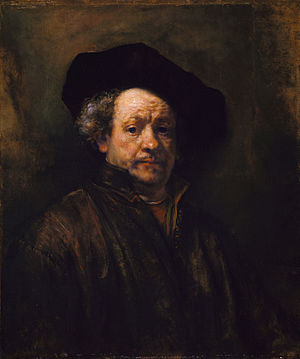|
Self-Portrait (Rembrandt, Altman)
Self-Portrait is a 1660 oil on canvas painting by the Dutch artist Rembrandt, one of over 40 self-portraits by Rembrandt. Painted when the artist was fifty-four, it has been noted as a work in which may be seen "the wrinkled brow and the worried expression the troubled condition of his mind".[1] Part of the Benjamin Altman Collection, it has been in the Metropolitan Museum of Art in New York City since 1913. DescriptionThe Altman portrait is dated 1660, when Rembrandt was fifty-four years old. This was an anxious year for him. He had just been declared bankrupt. His collection of art treasures was sold at auction. Meanwhile his pupils and friends distanced themselves from him. He also lost his studio space. In this portrait we have a work of mature years, when he brought all the skill and resources of a lifetime to its creation.[1] The lift of the eyebrows that wrinkle his forehead is that of whimsical impatience, yet the spark in his eyes denies defeat. The mouth is drawn and the mark of undeserved neglect is evident in the premature wrinkles, but a certain merry pride lurks in the tilted cap and raised head. A pang of pity shoots through us, only to be replaced by one of keen satisfaction that he, the neglected, is remembered and they, the aristocrats, are forgotten.[2] Though Rembrandt lived several years longer, they were years of misery, and he painted only one more great work, the group portrait "Syndics of the Drapers' Guild," now in the Rijksmuseum in Amsterdam. His great reputation suffered an almost total eclipse, although to-day he is probably the most popular painter that ever lived. Yet he never lost his courage, and as we see him in this portrait he carries his head bravely and wears his hat jauntily, as if in defiance of the evils that engulfed him. Heretofore we may have felt acquainted with Rembrandt the painter, but now we know Rembrandt the man; for just so he must have looked to his neighbors in the troublous year 1660.[1] CompositionA 1913 article said: "Technically this portrait shows Rembrandt at his best. The hat, a rich black, and the background, a warm green, are smoothly painted. The shadows in the face are thin, warm, and transparent, while the lighter parts, as on the cheek, are laid on with a well-loaded brush, suggesting the texture of the flesh and made to glow with color. Over a red waistcoat Rembrandt wears a heavy, brownish coat".[1] Provenance
Related self-portraits by Rembrandt In 1914 a Metropolitan Museum guide said: "Those who happen to be familiar with the self-portrait of a year or so earlier, belonging to Henry C. Frick, will find a comparison of the moods of that picture and our work an interesting one. In the portrait owned by Mr. Frick, though it was also painted in a troubled time, he paints himself as though he were a philosopher or prophet to whom all things but his own thoughts are indifferent. In the Altman picture he is prematurely aged by his troubles and is pestered with worries, "the little cares and anxieties of daily life." His forehead is wrinkled and the mouth is drawn, but the cap is tilted a little jauntily on one side and the head is erect and proud."[3] See alsoNotes
External linksWikimedia Commons has media related to Self-portrait (Rembrandt, 1660). |
||||||||||||||
Portal di Ensiklopedia Dunia
